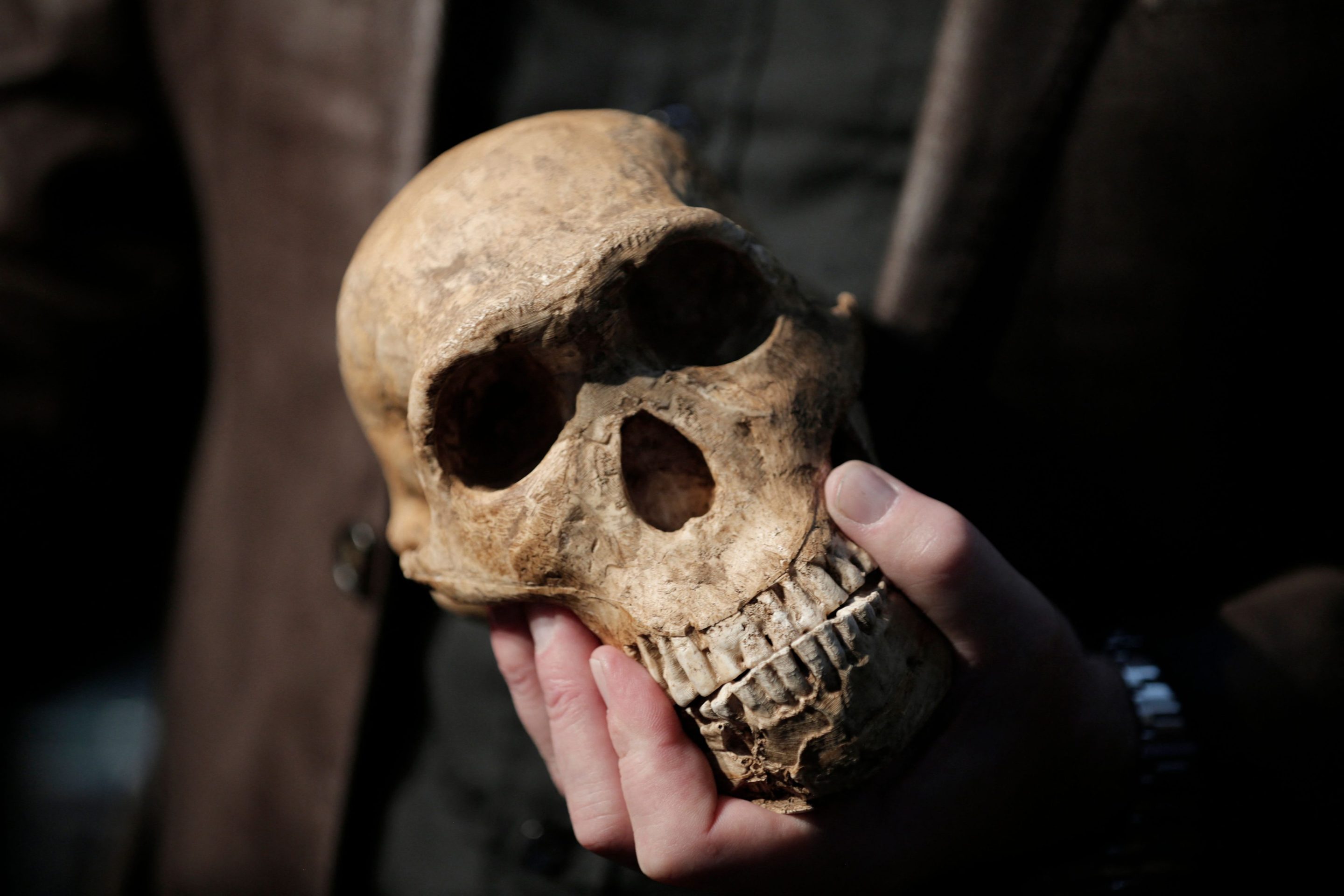Briana Pobiner, a paleoanthropologist at the Smithsonian Institution’s National Museum of Natural History, was examining a 1.45-million-year-old leg bone from an ancient hominin when she noticed strangely repetitive incisions resembling butchery marks, where stone tools might have removed a chunk of flesh from the bone. Researchers do not know what species of ancient hominin the leg belonged to, or what species may have sliced into the bone (Homo sapiens is exempt, having only evolved 300,000 years ago). In a paper published in June in the journal Scientific Reports, Pobiner and colleagues suggest the cut marks may be the earliest evidence of a human ancestor butchering another human, raising the possibility the leg was cannibalized.
With no evidence of the identity of the butcher or butchee, and no evidence of actual flesh consumption, the authors did not claim in the paper they'd found evidence of cannibalism. But some media outlets, hungry for cannibal representation, led with that theory—"Scientists Make Horrific Discovery About Cannibalism in Human Ancestors" teased Futurism and "Our Human Relatives Butchered and Ate Each Other 1.45 Million Years Ago" proclaimed Smithsonian. That lead to a haughty clapback from The New York Times, which ran the story "Cannibalism, or 'Clickbait'?" that seemed to lump Pobiner together with headline writers as a group too eager to find evidence of a cannibal, while also including one of the most specious quotes to recently grace the pages of the Gray Lady, courtesy of a retired archaeologist from the U.S. Army Corps of Engineers who proposed an alternative explanation for the bones: "Why not a murder victim or the result of an autistic humanoid doing self-harm?" Now there's a sentence I can never unread!
For all the drama, this wasn't even the biggest controversy this summer to spotlight the pitfalls scientists and journalists encounter when making research freely accessible, and interesting, to the general public.
A few weeks before the cannibal quarrel, the paleoanthropology community was rocked by another controversy driven by much more extraordinary claims. This bigger controversy revolved around Homo naledi, a stout species of ancient hominin that roamed Africa around the time of the first modern humans. A group of scientists led by Lee Berger, a paleoanthropologist at the University of Witwatersrand in Johannesburg, first discovered the remains of Homo naledi in the Rising Star Cave in South Africa. The bones rested at the bottom of a nearly 40-foot-long chute, the entrance to which is just seven-and-a-half inches long—hinting that the early hominins may have intentionally buried their dead.
In June, Berger's group reported they had finally found evidence that Homo naledi not only buried their dead, but also used fire to light their way in the caves, and engraved symbols in the rock walls of the cave—an astonishing trifecta of claims. Humans are the only species known to bury their dead, and the earliest known human grave is just 78,000 years old. And Homo naledi is estimated to have lived between 335,000 to 241,000 years ago, which would push back the date of the first burial by more than a hundred thousand years.
Berger and colleagues published their evidence in three preprint papers, which would later be published as "Reviewed Preprints" in the journal eLife, according to a press release. Preprints are manuscript drafts that are published online after research is conducted but before it has been peer-reviewed, where relevant experts vet the paper to ensure its conclusions are supported by the data and determine whether the paper should be published. Preprints skip this crucial step, an imperfect but standard practice, that allows reputable scholarly journals to maintain quality control. Sometimes papers originally published as preprints later land in a reputable journal relatively unscathed. And sometimes, like the souls in Hades's perpetual stew, preprints languish in unpublished purgatory on sites like bioRxiv, medRxiv, and arXiv. At their best, preprints make scientific findings freely available to the public earlier, and allow researchers time to incorporate feedback into the final version. At their worst, they overtly spread misinformation or erode public trust in science.
Most of the wall-to-wall press coverage of Homo naledi burying their dead noted these papers were preprints (although merely calling a study a preprint means nothing to readers who has never heard of a preprint). The most reputable of these news stories also noted the overwhelmingly skeptical response that other researchers had to these extraordinary claims, but many stories were far less critical, and some headlines stated the claim as a fact: Homo naledi buried their dead 100,000 years before humans, declared CNN. All this buzz was no doubt helped by the researchers' coordinated media blitz; the press release also announced the impending publication of Berger's new book, Cave of Bones: A True Story of Discovery, Adventure, and Human Origins, and a four-part Netflix documentary series.

But six days before Netflix dropped Unknown: Cave of Bones, eLife published four utterly scathing peer reviews of the burial preprint that found it incomplete, speculative, and inconclusive. The reviewers lobbed too many critiques to list here, but some included: 1) no evidence of a symbolic orientation of the dead, which would suggest intentional burial, 2) no evidence that a hole was dug for the body, another key aspect of a burial, and 3) a stone "artifact" the researchers suggested could be a grave good was not excavated, and could just be a cool rock. In the pithy words of anonymous reviewer #4: "In addition to a lack of evidence to support the claims of intentional burial, this paper was also written extremely poorly."
I am not a paleoanthropologist and am therefore unqualified to decide who is more right here (this story breaks down what kind of evidence could actually verify the claims). But I can see that extraordinary claims require extraordinary evidence, which this research group does not seem to have, despite the massive media push surrounding these preprints that may have motivated the researchers to publish results in some form before their Netflix series came out. (In a response to the reviews, the authors admit they originally sent these manuscripts to a "high-impact journal" that rejected the manuscript after asking for revisions that the researchers believed "could not be completed in a timely manner.")
As a science writer, I am annoyed by the lack of stories following up on the blockbuster, laudatory coverage to include these significant and severe critiques of the evidence behind this theory. (The one publication that did update their original story to incorporate the critical peer reviews was The Daily Princetonian—bless student journalists!) Amid the messy and often abstruse process of scientific publishing, journalists need to work harder to put these findings in context for readers. And the researchers should have been more responsible and waited a month for the peer reviews before embarking on their media campaign, to give reporters and the public a more informed look at their claims. And yet, when so much scientific research is locked away behind paywalls, it's not lost on me that anyone with internet can read the preprints and the reviews and see the scientific process in action—however chaotic, confusing, and dry.
Any science that deals with beings that lived hundreds of thousands of years ago is, to some degree, unknowable. We will never recover the full texture of their lives. As a human, of course I was excited when I first read that someone besides us may have buried their dead. But then I found myself asking: What is the big whoop about burial? The researchers describe burials as one of many mortuary practices found across human societies, implying that Homo naledi burying their dead would elevate these extinct hominins, who we often introduce as "small-brained," as intelligent and cultured, meaning just like us. But like sexy kissing, the funerary practice of burial is not universal to modern humans—consider cultures that practice exposure or sky burial.
I admire any researcher who is interested in excavating the personhood of ancient hominins. Just because they went extinct does not mean they did not have their own forms of intelligence, culture, and uniquely human ways of seeing the world. But is burial really so human? Whenever we fancy ourselves exceptional, there is often a creature that proves us wrong. Worker ants carry their dead brethren to a special chamber or even bury their dead. Elephants sometimes cover their dead with soil and vegetation and have complex rituals that resemble human mourning—intentional practices that are less likely to preserve over thousands of years. Isn't the intention and commemoration the true meaning of burial, rather than the practice of heaping sediment on a body?
Regardless if burial is proven, disproven, or, in the most likely scenario, argued about heatedly for years to come, the Rising Star Cave is an anthropological wonder. However the bones got to the bottom of a 40-foot chute, they will continue to illuminate a sliver of history that will teach us more about all humans. And whether the 1.45-million-year-old leg bone was cannibalized by another hominin, that leg bone will continue to teach us more about who it once belonged to, and if they eventually became someone's probably unseasoned lunch. (As far as cannibalism goes, why would you cut flesh from a bone if you weren't going to eat it? Life was harsh back then, and it seems to me a much more difficult task to prove early humans weren't eating each other.) If anything, this saga has left me with a lesson I will take to heart: One of the most effective strategies for science communication is being spicy on main.







